- Dutch
- Frisian
- Saterfrisian
- Afrikaans
-
- Phonology
- Segment inventory
- Phonotactics
- Phonological processes
- Phonology-morphology interface
- Word stress
- Primary stress in simplex words
- Monomorphemic words
- Diachronic aspects
- Generalizations on stress placement
- Default penultimate stress
- Lexical stress
- The closed penult restriction
- Final closed syllables
- The diphthong restriction
- Superheavy syllables (SHS)
- The three-syllable window
- Segmental restrictions
- Phonetic correlates
- Stress shifts in loanwords
- Quantity-sensitivity
- Secondary stress
- Vowel reduction in unstressed syllables
- Stress in complex words
- Primary stress in simplex words
- Accent & intonation
- Clitics
- Spelling
- Morphology
- Word formation
- Compounding
- Nominal compounds
- Verbal compounds
- Adjectival compounds
- Affixoids
- Coordinative compounds
- Synthetic compounds
- Reduplicative compounds
- Phrase-based compounds
- Elative compounds
- Exocentric compounds
- Linking elements
- Separable complex verbs (SCVs)
- Gapping of complex words
- Particle verbs
- Copulative compounds
- Derivation
- Numerals
- Derivation: inputs and input restrictions
- The meaning of affixes
- Non-native morphology
- Cohering and non-cohering affixes
- Prefixation
- Suffixation
- Nominal suffixation: person nouns
- Conversion
- Pseudo-participles
- Bound forms
- Nouns
- Nominal prefixes
- Nominal suffixes
- -aal and -eel
- -aar
- -aard
- -aat
- -air
- -aris
- -ast
- Diminutives
- -dom
- -een
- -ees
- -el (nominal)
- -elaar
- -enis
- -er (nominal)
- -erd
- -erik
- -es
- -eur
- -euse
- ge...te
- -heid
- -iaan, -aan
- -ief
- -iek
- -ier
- -ier (French)
- -ière
- -iet
- -igheid
- -ij and allomorphs
- -ijn
- -in
- -ing
- -isme
- -ist
- -iteit
- -ling
- -oir
- -oot
- -rice
- -schap
- -schap (de)
- -schap (het)
- -sel
- -st
- -ster
- -t
- -tal
- -te
- -voud
- Verbs
- Adjectives
- Adverbs
- Univerbation
- Neo-classical word formation
- Construction-dependent morphology
- Morphological productivity
- Compounding
- Inflection
- Inflection and derivation
- Allomorphy
- The interface between phonology and morphology
- Word formation
- Syntax
- Preface and acknowledgements
- Verbs and Verb Phrases
- 1 Characterization and classification
- 2 Projection of verb phrases I:Argument structure
- 3 Projection of verb phrases II:Verb frame alternations
- Introduction
- 3.1. Main types
- 3.2. Alternations involving the external argument
- 3.3. Alternations of noun phrases and PPs
- 3.3.1. Dative/PP alternations (dative shift)
- 3.3.1.1. Dative alternation with aan-phrases (recipients)
- 3.3.1.2. Dative alternation with naar-phrases (goals)
- 3.3.1.3. Dative alternation with van-phrases (sources)
- 3.3.1.4. Dative alternation with bij-phrases (possessors)
- 3.3.1.5. Dative alternation with voor-phrases (benefactives)
- 3.3.1.6. Conclusion
- 3.3.1.7. Bibliographical notes
- 3.3.2. Accusative/PP alternations
- 3.3.3. Nominative/PP alternations
- 3.3.1. Dative/PP alternations (dative shift)
- 3.4. Some apparent cases of verb frame alternation
- 3.5. Bibliographical notes
- 4 Projection of verb phrases IIIa:Selection of clauses/verb phrases
- 5 Projection of verb phrases IIIb:Argument and complementive clauses
- Introduction
- 5.1. Finite argument clauses
- 5.2. Infinitival argument clauses
- 5.3. Complementive clauses
- 6 Projection of verb phrases IIIc:Complements of non-main verbs
- 7 Projection of verb phrases IIId:Verb clusters
- 8 Projection of verb phrases IV: Adverbial modification
- 9 Word order in the clause I:General introduction
- 10 Word order in the clause II:Position of the finite verb (verb-first/second)
- 11 Word order in the clause III:Clause-initial position (wh-movement)
- Introduction
- 11.1. The formation of V1- and V2-clauses
- 11.2. Clause-initial position remains (phonetically) empty
- 11.3. Clause-initial position is filled
- 12 Word order in the clause IV:Postverbal field (extraposition)
- 13 Word order in the clause V: Middle field (scrambling)
- 14 Main-clause external elements
- Nouns and Noun Phrases
- 1 Characterization and classification
- 2 Projection of noun phrases I: complementation
- Introduction
- 2.1. General observations
- 2.2. Prepositional and nominal complements
- 2.3. Clausal complements
- 2.4. Bibliographical notes
- 3 Projection of noun phrases II: modification
- Introduction
- 3.1. Restrictive and non-restrictive modifiers
- 3.2. Premodification
- 3.3. Postmodification
- 3.3.1. Adpositional phrases
- 3.3.2. Relative clauses
- 3.3.3. Infinitival clauses
- 3.3.4. A special case: clauses referring to a proposition
- 3.3.5. Adjectival phrases
- 3.3.6. Adverbial postmodification
- 3.4. Bibliographical notes
- 4 Projection of noun phrases III: binominal constructions
- Introduction
- 4.1. Binominal constructions without a preposition
- 4.2. Binominal constructions with a preposition
- 4.3. Bibliographical notes
- 5 Determiners: articles and pronouns
- Introduction
- 5.1. Articles
- 5.2. Pronouns
- 5.3. Bibliographical notes
- 6 Numerals and quantifiers
- 7 Pre-determiners
- Introduction
- 7.1. The universal quantifier al 'all' and its alternants
- 7.2. The pre-determiner heel 'all/whole'
- 7.3. A note on focus particles
- 7.4. Bibliographical notes
- 8 Syntactic uses of noun phrases
- Adjectives and Adjective Phrases
- 1 Characteristics and classification
- 2 Projection of adjective phrases I: Complementation
- 3 Projection of adjective phrases II: Modification
- 4 Projection of adjective phrases III: Comparison
- 5 Attributive use of the adjective phrase
- 6 Predicative use of the adjective phrase
- 7 The partitive genitive construction
- 8 Adverbial use of the adjective phrase
- 9 Participles and infinitives: their adjectival use
- 10 Special constructions
- Adpositions and adpositional phrases
- 1 Characteristics and classification
- Introduction
- 1.1. Characterization of the category adposition
- 1.2. A formal classification of adpositional phrases
- 1.3. A semantic classification of adpositional phrases
- 1.3.1. Spatial adpositions
- 1.3.2. Temporal adpositions
- 1.3.3. Non-spatial/temporal prepositions
- 1.4. Borderline cases
- 1.5. Bibliographical notes
- 2 Projection of adpositional phrases: Complementation
- 3 Projection of adpositional phrases: Modification
- 4 Syntactic uses of the adpositional phrase
- 5 R-pronominalization and R-words
- 1 Characteristics and classification
- Phonology
-
- General
- Phonology
- Segment inventory
- Phonotactics
- Phonological Processes
- Assimilation
- Vowel nasalization
- Syllabic sonorants
- Final devoicing
- Fake geminates
- Vowel hiatus resolution
- Vowel reduction introduction
- Schwa deletion
- Schwa insertion
- /r/-deletion
- d-insertion
- {s/z}-insertion
- t-deletion
- Intrusive stop formation
- Breaking
- Vowel shortening
- h-deletion
- Replacement of the glide w
- Word stress
- Clitics
- Allomorphy
- Orthography of Frisian
- Morphology
- Inflection
- Word formation
- Derivation
- Prefixation
- Infixation
- Suffixation
- Nominal suffixes
- Verbal suffixes
- Adjectival suffixes
- Adverbial suffixes
- Numeral suffixes
- Interjectional suffixes
- Onomastic suffixes
- Conversion
- Compositions
- Derivation
- Syntax
- Verbs and Verb Phrases
- Characteristics and classification
- Unergative and unaccusative subjects
- Evidentiality
- To-infinitival clauses
- Predication and noun incorporation
- Ellipsis
- Imperativus-pro-Infinitivo
- Expression of irrealis
- Embedded Verb Second
- Agreement
- Negation
- Nouns & Noun Phrases
- Classification
- Complementation
- Modification
- Partitive noun constructions
- Referential partitive constructions
- Partitive measure nouns
- Numeral partitive constructions
- Partitive question constructions
- Nominalised quantifiers
- Kind partitives
- Partitive predication with prepositions
- Bare nominal attributions
- Articles and names
- Pronouns
- Quantifiers and (pre)determiners
- Interrogative pronouns
- R-pronouns
- Syntactic uses
- Adjective Phrases
- Characteristics and classification
- Complementation
- Modification and degree quantification
- Comparison by degree
- Comparative
- Superlative
- Equative
- Attribution
- Agreement
- Attributive adjectives vs. prenominal elements
- Complex adjectives
- Noun ellipsis
- Co-occurring adjectives
- Predication
- Partitive adjective constructions
- Adverbial use
- Participles and infinitives
- Adposition Phrases
- Characteristics and classification
- Complementation
- Modification
- Intransitive adpositions
- Predication
- Preposition stranding
- Verbs and Verb Phrases
-
- General
- Morphology
- Morphology
- 1 Word formation
- 1.1 Compounding
- 1.1.1 Compounds and their heads
- 1.1.2 Special types of compounds
- 1.1.2.1 Affixoids
- 1.1.2.2 Coordinative compounds
- 1.1.2.3 Synthetic compounds and complex pseudo-participles
- 1.1.2.4 Reduplicative compounds
- 1.1.2.5 Phrase-based compounds
- 1.1.2.6 Elative compounds
- 1.1.2.7 Exocentric compounds
- 1.1.2.8 Linking elements
- 1.1.2.9 Separable Complex Verbs and Particle Verbs
- 1.1.2.10 Noun Incorporation Verbs
- 1.1.2.11 Gapping
- 1.2 Derivation
- 1.3 Minor patterns of word formation
- 1.1 Compounding
- 2 Inflection
- 1 Word formation
- Morphology
- Syntax
- Adjectives and adjective phrases (APs)
- 0 Introduction to the AP
- 1 Characteristics and classification of APs
- 2 Complementation of APs
- 3 Modification and degree quantification of APs
- 4 Comparison by comparative, superlative and equative
- 5 Attribution of APs
- 6 Predication of APs
- 7 The partitive adjective construction
- 8 Adverbial use of APs
- 9 Participles and infinitives as APs
- Nouns and Noun Phrases (NPs)
- 0 Introduction to the NP
- 1 Characteristics and Classification of NPs
- 2 Complementation of NPs
- 3 Modification of NPs
- 3.1 Modification of NP by Determiners and APs
- 3.2 Modification of NP by PP
- 3.3 Modification of NP by adverbial clauses
- 3.4 Modification of NP by possessors
- 3.5 Modification of NP by relative clauses
- 3.6 Modification of NP in a cleft construction
- 3.7 Free relative clauses and selected interrogative clauses
- 4 Partitive noun constructions and constructions related to them
- 4.1 The referential partitive construction
- 4.2 The partitive construction of abstract quantity
- 4.3 The numerical partitive construction
- 4.4 The partitive interrogative construction
- 4.5 Adjectival, nominal and nominalised partitive quantifiers
- 4.6 Kind partitives
- 4.7 Partitive predication with a preposition
- 4.8 Bare nominal attribution
- 5 Articles and names
- 6 Pronouns
- 7 Quantifiers, determiners and predeterminers
- 8 Interrogative pronouns
- 9 R-pronouns and the indefinite expletive
- 10 Syntactic functions of Noun Phrases
- Adpositions and Adpositional Phrases (PPs)
- 0 Introduction to the PP
- 1 Characteristics and classification of PPs
- 2 Complementation of PPs
- 3 Modification of PPs
- 4 Bare (intransitive) adpositions
- 5 Predication of PPs
- 6 Form and distribution of adpositions with respect to staticity and construction type
- 7 Adpositional complements and adverbials
- Verbs and Verb Phrases (VPs)
- 0 Introduction to the VP in Saterland Frisian
- 1 Characteristics and classification of verbs
- 2 Unergative and unaccusative subjects and the auxiliary of the perfect
- 3 Evidentiality in relation to perception and epistemicity
- 4 Types of to-infinitival constituents
- 5 Predication
- 5.1 The auxiliary of being and its selection restrictions
- 5.2 The auxiliary of going and its selection restrictions
- 5.3 The auxiliary of continuation and its selection restrictions
- 5.4 The auxiliary of coming and its selection restrictions
- 5.5 Modal auxiliaries and their selection restrictions
- 5.6 Auxiliaries of body posture and aspect and their selection restrictions
- 5.7 Transitive verbs of predication
- 5.8 The auxiliary of doing used as a semantically empty finite auxiliary
- 5.9 Supplementive predication
- 6 The verbal paradigm, irregularity and suppletion
- 7 Verb Second and the word order in main and embedded clauses
- 8 Various aspects of clause structure
- Adjectives and adjective phrases (APs)
-
- General
- Phonology
- Afrikaans phonology
- Segment inventory
- Overview of Afrikaans vowels
- The diphthongised long vowels /e/, /ø/ and /o/
- The unrounded mid-front vowel /ɛ/
- The unrounded low-central vowel /ɑ/
- The unrounded low-central vowel /a/
- The rounded mid-high back vowel /ɔ/
- The rounded high back vowel /u/
- The rounded and unrounded high front vowels /i/ and /y/
- The unrounded and rounded central vowels /ə/ and /œ/
- The diphthongs /əi/, /œy/ and /œu/
- Overview of Afrikaans consonants
- The bilabial plosives /p/ and /b/
- The alveolar plosives /t/ and /d/
- The velar plosives /k/ and /g/
- The bilabial nasal /m/
- The alveolar nasal /n/
- The velar nasal /ŋ/
- The trill /r/
- The lateral liquid /l/
- The alveolar fricative /s/
- The velar fricative /x/
- The labiodental fricatives /f/ and /v/
- The approximants /ɦ/, /j/ and /ʋ/
- Overview of Afrikaans vowels
- Word stress
- The phonetic properties of stress
- Primary stress on monomorphemic words in Afrikaans
- Background to primary stress in monomorphemes in Afrikaans
- Overview of the Main Stress Rule of Afrikaans
- The short vowels of Afrikaans
- Long vowels in monomorphemes
- Primary stress on diphthongs in monomorphemes
- Exceptions
- Stress shifts in place names
- Stress shift towards word-final position
- Stress pattern of reduplications
- Phonological processes
- Vowel related processes
- Consonant related processes
- Homorganic glide insertion
- Phonology-morphology interface
- Phonotactics
- Morphology
- Syntax
- Afrikaans syntax
- Nouns and noun phrases
- Characteristics of the NP
- Classification of nouns
- Complementation of NPs
- Modification of NPs
- Binominal and partitive constructions
- Referential partitive constructions
- Partitive measure nouns
- Numeral partitive constructions
- Partitive question constructions
- Partitive constructions with nominalised quantifiers
- Partitive predication with prepositions
- Binominal name constructions
- Binominal genitive constructions
- Bare nominal attribution
- Articles and names
- Pronouns
- Quantifiers, determiners and predeterminers
- Syntactic uses of the noun phrase
- Adjectives and adjective phrases
- Characteristics and classification of the AP
- Complementation of APs
- Modification and Degree Quantification of APs
- Comparison by comparative, superlative and equative degree
- Attribution of APs
- Predication of APs
- The partitive adjective construction
- Adverbial use of APs
- Participles and infinitives as adjectives
- Verbs and verb phrases
- Characterisation and classification
- Argument structure
- Verb frame alternations
- Complements of non-main verbs
- Verb clusters
- Complement clauses
- Adverbial modification
- Word order in the clause: Introduction
- Word order in the clause: position of the finite Verb
- Word order in the clause: Clause-initial position
- Word order in the clause: Extraposition and right-dislocation in the postverbal field
- Word order in the middle field
- Emphatic constructions
- Adpositions and adposition phrases
The following lists of segmental frequencies were extracted from the phonetically transcribed part of the Dutch Celex database (Baayen et al. 1995). The syllable boundaries provided in Celex were used. All syllables were classified as either being monosyllables (originating from monosyllabic words), stressed polysyllables or unstressed polysyllables (i.e. the stressed or unstressed syllable of a polysyllabic word). Subsequently, each syllable was parsed into a positional syllable template differentiating onset, nucleus and coda positions. The numbers in the following tables are based on the number of entities per syllable position.
Please note that ambisyllabic consonants are not tagged as such in the Celex database. They are consistently classified as onset consonants, which means that B-class vowels in polysyllabic words appear in open syllables in the Celex transcriptions. As a result, the numbers presented for coda consonants in polysyllabic words and in all words combined may be skewed.
Furthermore, the Celex (word) frequency count of 486 cases (out of 5380) is specified as zero - although these words are present in the Celex database. The frequency count of zero was taken over for the syllable counts.
A searchable xls-file with the raw Celex count data can be found here. Examples are provided for each syllable type. Moreover, the data set can be filtered with respect to word type (monosyllabic or polysyllabic word), stress type (stressed or unstressed syllable), each syllable position and all combinations of these elements. Celex token and type frequencies of the filtered data are given in the top left corner of the xls-file.
- Applied syllable template
- Consonants in onsets of monosyllabic words
- Consonants in onsets of stressed syllables in polysyllabic words
- Consonants in onsets of unstressed syllables in polysyllabic words
- Consonants in codas of monosyllabic words
- Consonants in codas of stressed syllables in polysyllabic words
- Consonants in codas of unstressed syllables in polysyllabic words
Each syllable specified in the Celex database was classified as being part of a monosyllabic or polysyllabic word and as being stressed or unstressed. As a second step, each syllable was parsed into a ten-position syllable template distinguishing not only onset, nucleus and coda positions but also more specific positions within onsets and codas.
In case a different syllable approach is applied, the reader is referred to the searchable xls-file with the raw Celex count data. With the help of the provided filters (available `blank' option in filter if empty position is required), positional frequency data for most syllable models should be obtainable.
Onset clusters of two segments containing an /s/ were further subdivided into /s/+sonorant clusters and /s/+obstruent clusters. /s/+obstruent clusters such as in speel /spel/ game were treated in accordance with /sCC-/ clusters, i.e. that the /s/ was assigned the appendix position and the obstruent was assigned the head position. In contrast, /s/+sonorant clusters as in slaap /slap/ sleep were counted separately in that the /s/ was assigned the s-position and the sonorant the sonorant-position (see table below). If a phonological approach is followed in which /s/+sonorant clusters are identical to other /CC-/ clusters, the /s/-position should be collapsed with the head position and the sonorant-position should be collapsed with the dependent position. In case an approach is followed that identifies the /s/ in /s/+sonorant clusters with other /sC(C)/ clusters, the /s/-position should be collapsed with the appendix position and the sonorant-position should be collapsed with the head or dependent position.
In addition to the two appendix positions / extra-prosodic consonants (e.g. the two final coronal consonants in herfst /hɛrfst/ autumn, fall), a distinction was made between the obligatory coda consonant following B-class vowels (as the /t/ in kat /kɑt/ cat) and the optional consonant following either an A-class vowel or a B-class vowel + consonant - sequence (e.g. the final obstruents in the examples taak /tak/ task or hulp /hʏlp/ help). What these consonants have in common is that they do not need to be coronals and, therefore, differ from appendix consonants. Van Oostendorp claims that these optional consonants do not actually belong to the coda / rhyme of the syllable but get assigned to a following degenerate syllable instead. These optional consonants are, therefore, called extra-syllabic consonants. Notice that for some loanwords, non-coronal consonants of final complex consonant clusters had to be assigned the appendix positions.
The following table summarizes the type and token frequencies of which each Dutch segment occurs in different onset syllable positions in monosyllabic words based on the Celex frequency data. See Applied syllable template for an explanation of the treatment of /CC-/ clusters.
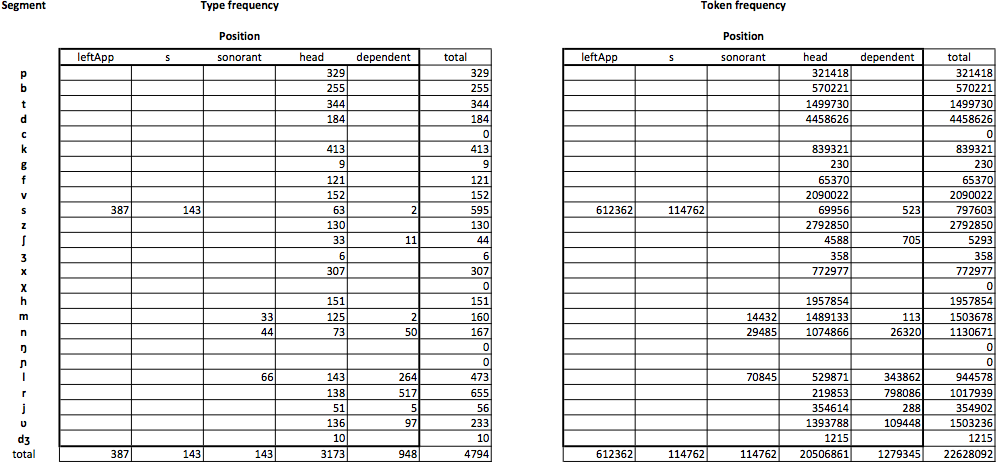
The following table summarizes the type and token frequencies of which each Dutch segment occurs in different onset syllable positions in stressed syllables of polysyllabic words based on the Celex frequency data. See Applied syllable template for an explanation of the treatment of /CC-/ clusters.
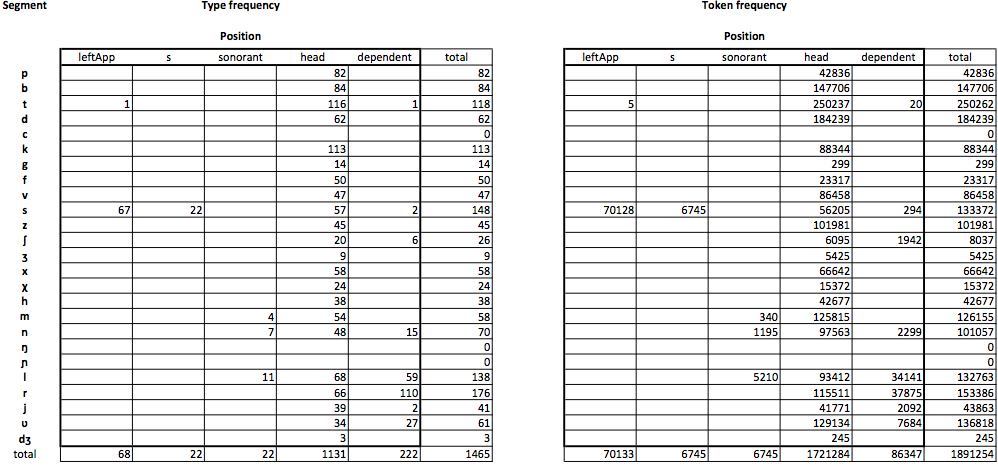
The following table summarizes the type and token frequencies of which each Dutch segment occurs in different onset syllable positions in unstressed syllables of polysyllabic words based on the Celex frequency data. See Applied syllable template for an explanation of the treatment of /CC-/ clusters.
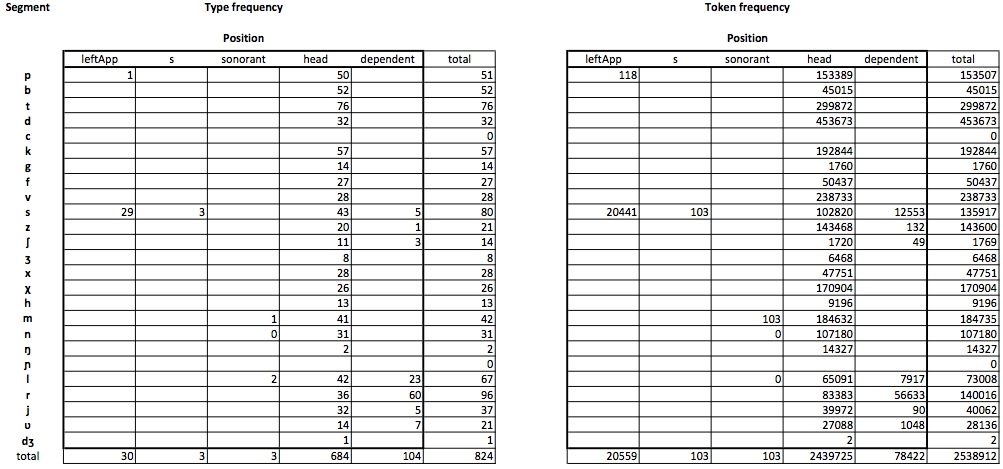
The following table summarizes the type and token frequencies of which each Dutch segment occurs in different coda syllable positions in monosyllabic words based on the Celex frequency data. See Applied syllable template for an explanation of the treatment of /-CC(C)/ clusters.
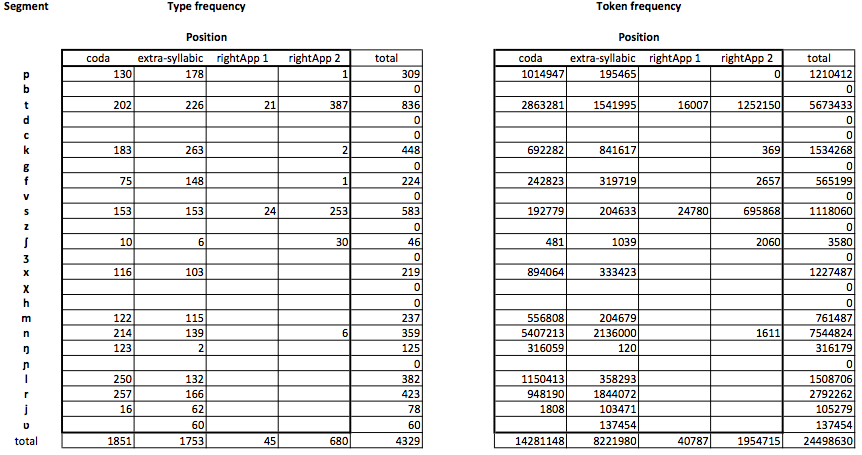
The following table summarizes the type and token frequencies of which each Dutch segment occurs in different coda syllable positions in stressed syllables of polysyllabic words based on the Celex frequency data. See Applied syllable template for an explanation of the treatment of /-CC(C)/ clusters.
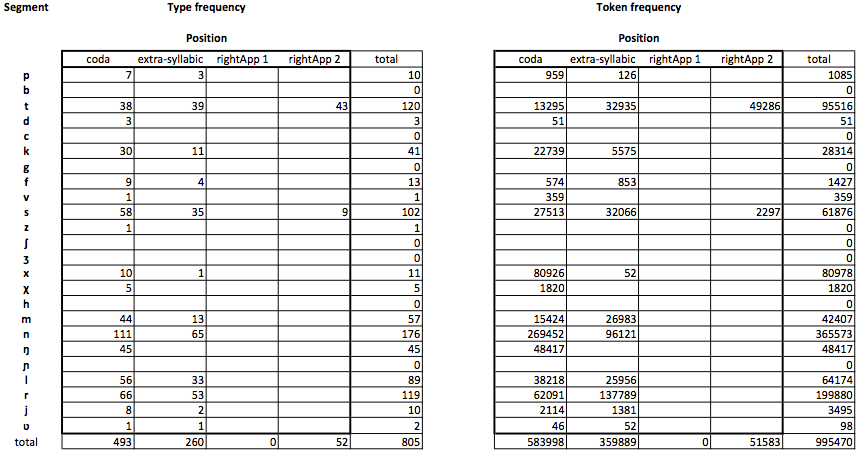
The following table summarizes the type and token frequencies of which each Dutch segment occurs in different coda syllable positions in unstressed syllables of polysyllabic words based on the Celex frequency data. See Applied syllable template for an explanation of the treatment of /-CC(C)/ clusters.
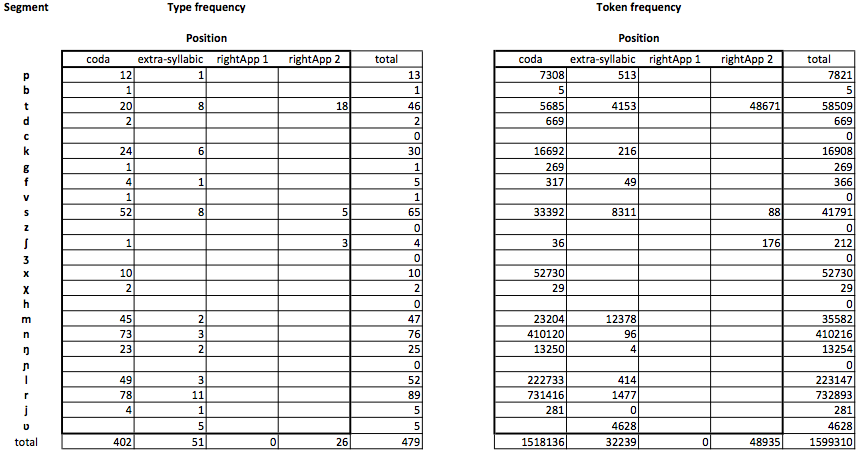
Segmental frequency data are also available for all Dutch segments combined, as well as separately for vowels and consonants.
- 1995The CELEX Lexical Database (CD-ROM), Release 2, Dutch Version 3.1
- 1995Vowel Quality and Phonological ProjectionTilburg UniversityThesis
- 2000Phonological ProjectionNiemeyer
